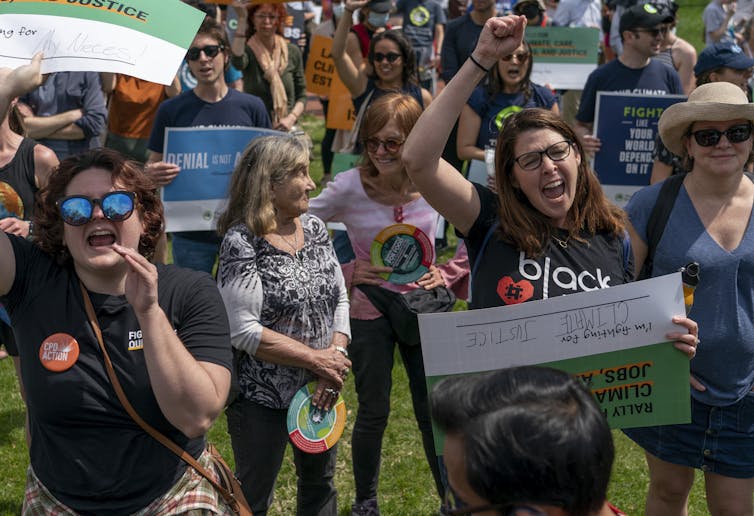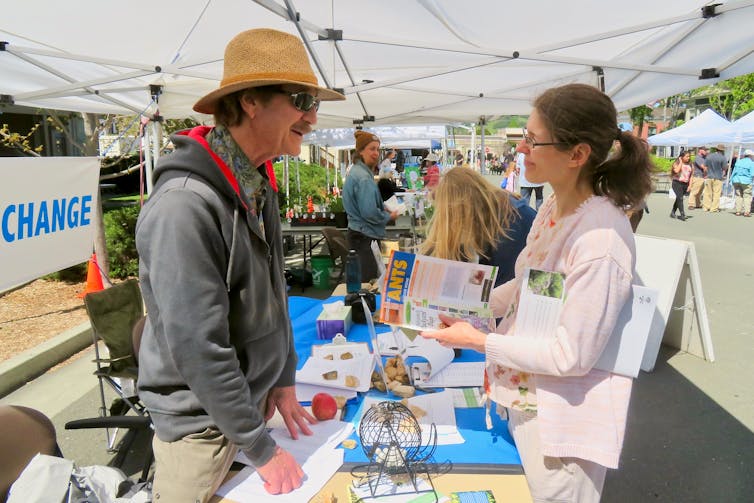
Dana R. Fisher, American University
As Earth Month 2024 gets underway, climate activists around the world are planning rallies and other events over the coming weeks to draw attention to the growing threats posed by climate change.
Many of these demonstrations will focus on what humanity can do to stop fueling the damage. But while activists are amplifying the dire findings from scientists, you’ll likely see fossil fuel supporters attacking them on social media and TV.
It’s easy to get caught up in the myths about climate activism, particularly in today’s polarized political environment. So, let’s take a moment to explore the truth about three of the big myths being told about climate activism and the climate movement today.
Myth 1: Climate activists are just young people
The media tends to focus most of its attention on young people in the climate movement, including those inspired by Greta Thunberg’s school strikes for climate, the international Fridays for Future, or the Sunrise Movement, which focuses on U.S. climate action.
Nevertheless, a substantial proportion of the active climate movement today is made up of older adults, including those called “climate grannies” and the “rocking chair rebellion.”
Just as young people have outspoken climate leaders, many of these older activists were inspired to get involved by longtime activists such as Jane Fonda and Bill McKibben and the group McKibben started specifically to mobilize older Americans: ThirdAct. As my research has found, these more mature activists cut their teeth in the civil rights and anti-war movements, along with earlier waves of the environmental movement.

Over the past 25 years, I have surveyed numerous waves of activists participating in demonstrations and protests to understand who they are and what motivates them to participate in activism. My new book, “Saving Ourselves: From Climate Shocks to Climate Action,” brings these findings together to understand how the climate movement has evolved along with the climate crisis.
When I surveyed participants at the March to End Fossil Fuels, which drew 75,000 people in New York City in September 2023, a quarter of the crowd was 53 years old or older. At a much smaller demonstration that targeted the White House Correspondents’ Association dinner in April 2023, I found the average age of the activists was 52, and a quarter of them were 69 or older.
Myth 2: Climate activists mostly do things like throw soup and disrupt events
While the activists engaging in civil disobedience, such as throwing soup on famous paintings or disrupting sports events, get the lion’s share of the media attention, the climate movement includes a wide spectrum of environmentally concerned activists using a broad range of tactics.
Activists are actively working to get climate-concerned candidates elected, pressure corporations to cut their emissions, encourage schools and municipalities to transition to electric buses, and make front-line communities more resilient to climate shocks, among many other efforts to slow climate change.

Many activists are involved with established organizations, such as 350.org, the Environmental Defense Fund and the Citizens’ Climate Lobby. Their numbers – EDF alone claims 3 million supporters – and financial strength can give them a powerful voice.
Others participate in less formal groups that make up the radical flank, such as Extinction Rebellion and Climate Defiance. Although these factions of the movement do not necessarily agree on the path to social change, they share the same mission: to end the climate crisis.
Myth 3: Confrontational climate activism doesn’t work
In recent months, protesters have thrown soup at the Mona Lisa, dumped pink powder on the U.S. Constitution and disrupted a Broadway show, among other events. These confrontational actions are not generally popular, but neither were the radical tactics of earlier social movements.
In 1961, 61% of the U.S. population disapproved of the Freedom Riders, who rode interstate buses into the South to challenge segregation. And 57% thought that sit-ins at lunch counters and other locations where Black Americans were refused service hurt the Civil Rights Movement. In hindsight, research has shown how essential those efforts were to the success of the Civil Rights Movement.
Nonviolent civil disobedience in the climate movement also plays an important role in keeping climate change in the media and on people’s minds.
Even though the radical flank of the climate movement is not particularly popular with the general public, there is no evidence that it is turning off other activists in the movement. In fact, there is reason to believe that confrontational acts can help mobilize sympathizers to support more moderate efforts of the climate movement.
When I asked participants at the 2023 March to End Fossil Fuels if they supported climate groups doing nonviolent civil disobedience, not one of the respondents reported disapproving of these groups and their actions.
The impact of these activists’ efforts goes well beyond media coverage, too. For example, when President Joe Biden announced his decision to pause approvals of liquefied natural gas exports in January 2024, he mentioned climate activists: “We will heed the calls of young people and frontline communities who are using their voices to demand action from those with the power to act.”
Myths about climate change are often spread to try to slow efforts to deal with climate change and are often funded by fossil fuel interests.
But that isn’t stopping climate activists, who, like the rest of the world, are experiencing climate change and feel a responsibility to speak out.![]()
Dana R. Fisher, Director of the Center for Environment, Community & Equity and Professor in the School of International Service, American University
This article is republished from The Conversation under a Creative Commons license. Read the original article.